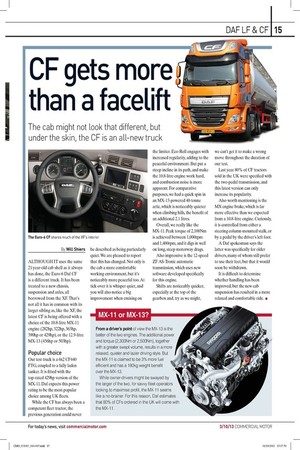CF gets than a facelift
Page 11

If you've noticed an error in this article please click here to report it so we can fix it.
The cab might not look that different, but under the skin, the CF is an all-new truck By Will Shiers
ALTHOUGH IT uses the same 21-year-old cab shell as it always has done, the Euro-6 Daf CF is a different truck. It has been treated to a new chassis, suspension and axles, all borrowed from the XF. That's not all it has in common with its larger sibling as, like the XF, the latest CF is being offered with a choice of the 10.8-litre MX-11 engine (282hp, 322hp, 363hp, 390hp or 429hp), or the 12.9-litre MX-13 (456hp or 503hp). Popular choice
Our test truck is a 6x2 CF440 FTG, coupled to a fully laden tanker. It is fitted with the top-rated 429hp version of the MX-11. Daf expects this power rating to be the most popular choice among UK fleets. While the CF has always been a competent fleet tractor, the previous generation could never be described as being particularly quiet. We are pleased to report that this has changed. Not only is the cab a more comfortable working environment, but it's noticeably more peaceful too. At tick-over it is whisper quiet, and you will also notice a big improvement when cruising on
the limiter. Eco-Roll engages with increased regularity, adding to the peaceful environment. But put a steep incline in its path, and make the 10.8-litre engine work hard, and combustion noise is more apparent. For comparative purposes, we had a quick spin in an MX-13-powered 40-tonne artic, which is noticeably quieter when climbing hills, the benefit of an additional 2.1 litres.
Overall, we really like the MX-11. Peak torque of 2,100Nm is achieved between 1,000rpm and 1,400rpm, and it digs in well on long, steep motorway drags.
Also impressive is the 12-speed ZF AS-Tronic automatic transmission, which uses new software developed specifically for this engine. Shifts are noticeably quicker, especially at the top of the gearbox and, try as we might,
we can't get it to make a wrong move throughout the duration of our test.
Last year 80% of CF tractors sold in the UK were specified with the two-pedal transmission, and this latest version can only increase its popularity.
Also worth mentioning is the MX engine brake, which is far more effective than we expected from a 10.8-litre engine. Curiously, it is controlled from either a steering column-mounted stalk, or by a pedal by the driver's left foot.
A Daf spokesman says the latter was specifically for older drivers, many of whom still prefer to use their feet, but that it would soon be withdrawn. It is difficult to determine whether handling has been improved, but the new cab suspension has resulted in a more relaxed and comfortable ride. •
MX-11 or MX-13?
From a driver's point of view the MX-13 is the better of the two engines. The additional power and torque (2,300Nm or 2,500Nm), together with a greater swept volume, results in a more relaxed, quieter and lazier driving style. But the MX-11 is claimed to be 3% more fuel efficient and has a 180kg weight benefit over the MX-13.
While owner-drivers might be swayed by the larger of the two, for savvy fleet operators looking to maximise profit, the MX-11 seems like a no-brainer. For this reason, Daf estimates that 80% of CFs ordered in the UK will come with the MX-11.











































